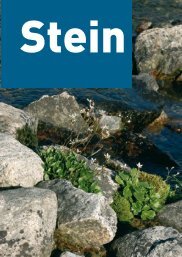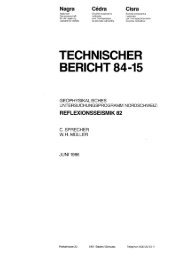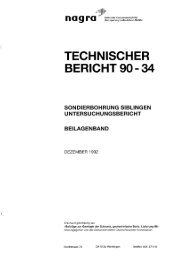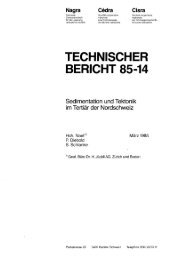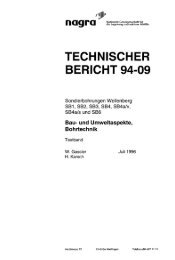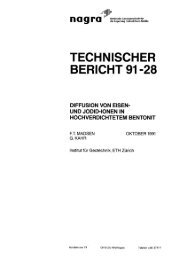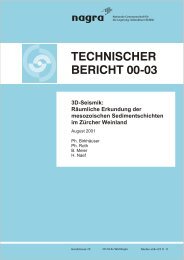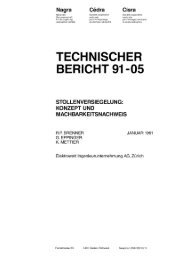Deutsch (27.2 MB) - Nagra
Deutsch (27.2 MB) - Nagra
Deutsch (27.2 MB) - Nagra
Sie wollen auch ein ePaper? Erhöhen Sie die Reichweite Ihrer Titel.
YUMPU macht aus Druck-PDFs automatisch weboptimierte ePaper, die Google liebt.
showed that the water from the upper part of the<br />
Permian (1'116.5 m) is a saline Na-CI-(S04)-water<br />
with mineralisation of around 36 gIl. The sample<br />
from the lower part of the Permian (1'408.3 m) is an<br />
Na-Ca-CI water with mineralisation of 98 gIl.<br />
It is assumed that both samples from the Permian<br />
are saturated with calcite. The model calculations<br />
also showed a slight undersaturation for dolomite.<br />
The sample from the upper part of the Permian is in<br />
equililbrium with gypsum and anhydrite while the<br />
water from the lower part is undersaturated with<br />
respect to these two minerals. The water from the<br />
upper part of the Permian is in equilibrium with<br />
quartz. The same has to be assumed for the water<br />
from the lower part of the Permian. In a regional<br />
comparison, the Permian waters proved to have a<br />
significantly higher mineralisation than all other<br />
known waters from the Buntsandstein,· Permian or<br />
Crystalline in the investigated area.<br />
It can be concluded from the 8 2 H- and 8 1S _ values<br />
and from noble gas analyses that the Permian waters<br />
originate from a period with a warmer climate. It can<br />
not be excluded that they still contain some old seawater.<br />
As yet, no positive statements can be made<br />
with regard to age.<br />
Water-flow in the Crystalline of Weiach is restricted<br />
to a few zones with increased permeability. Only two<br />
groundwater samples could be taken. Analyses showed<br />
that the waters (from 2'218.1 m and 2'267.0 m)<br />
are relatively highly mineralised Na-CI waters (7 gIl).<br />
Model calculations show saturation with calcite and<br />
quartz but the waters are clearly undersaturated with<br />
respect to dolomite, gypsum, anhydrite and chalcedony.<br />
Of all the Crystalline waters in <strong>Nagra</strong>'s investigation<br />
area, there is no direct equivalent of the Weiach Crystalline<br />
waters. The results of isotope measurements<br />
(8 2 H-, 8 1S O- and 8 34 S-measurements in dissolved<br />
sulphate) point to independent development within<br />
the crystalline rock. It is not yet possible to make any<br />
defmite statements about the age of the waters.<br />
The Water-Flow Systems in the Weiach Crystalline<br />
The Crystalline in the Weiach borehole generally has<br />
a very low permeability. The permeability of the solid<br />
unfractured rock is in the order of lx10- 1 2m/s, or<br />
even lower. The effective overall transmissivity of the<br />
Crystalline drilled through (T = 1x10-sm2/s) is basically<br />
determined by zones of increased hydraulic<br />
permeability (transmissivities up to T = 4x10-9m2/s).<br />
These zones of increased permeability are irregular<br />
networks with some open fractures which are associated<br />
with the aplite dykes and their surrounding<br />
rock. Water-flow therefore basically occurs in a single<br />
system type which, at least for the present, cannot<br />
be further differentiated.<br />
Six water-bearing zones were found over a section of<br />
around 460 m in the Crystalline of the Weiach borehole.<br />
There is very little information on their threedimensional<br />
orientation and extent. The same is true<br />
of the aplite dykes with which they are apparently<br />
associated. In the drilling profile, the apparent<br />
thickness of the water-bearing aplite dykes can be up<br />
to several meters. Based on the frequency of their<br />
occurrence, it can be assumed that they form a more<br />
or less interconnected irregular network of waterbearing<br />
zones in. otherwise low-permeability crystalline<br />
rocks.<br />
To date, there have been no detailed investigations<br />
of the porosity distribution in the immediate vicinity<br />
of fractures. Individual measurements of aplite<br />
samples gave open porosities between 1.26 and 1.41<br />
Vol.-%, which is comparable with the open porosities<br />
of fresh unaltered gneiss (1.05-1.72 Vol.-%).<br />
Gneisses which have been hydrothermally altered<br />
and subjected to cataclasis may have higher open<br />
porosities, with an increase primarily in the open<br />
microporosity. With the data available, it is not clear<br />
whether the water-bearing zones tend to be associated<br />
more with areas which have undergone cataclasis<br />
or those which have not been altered.



